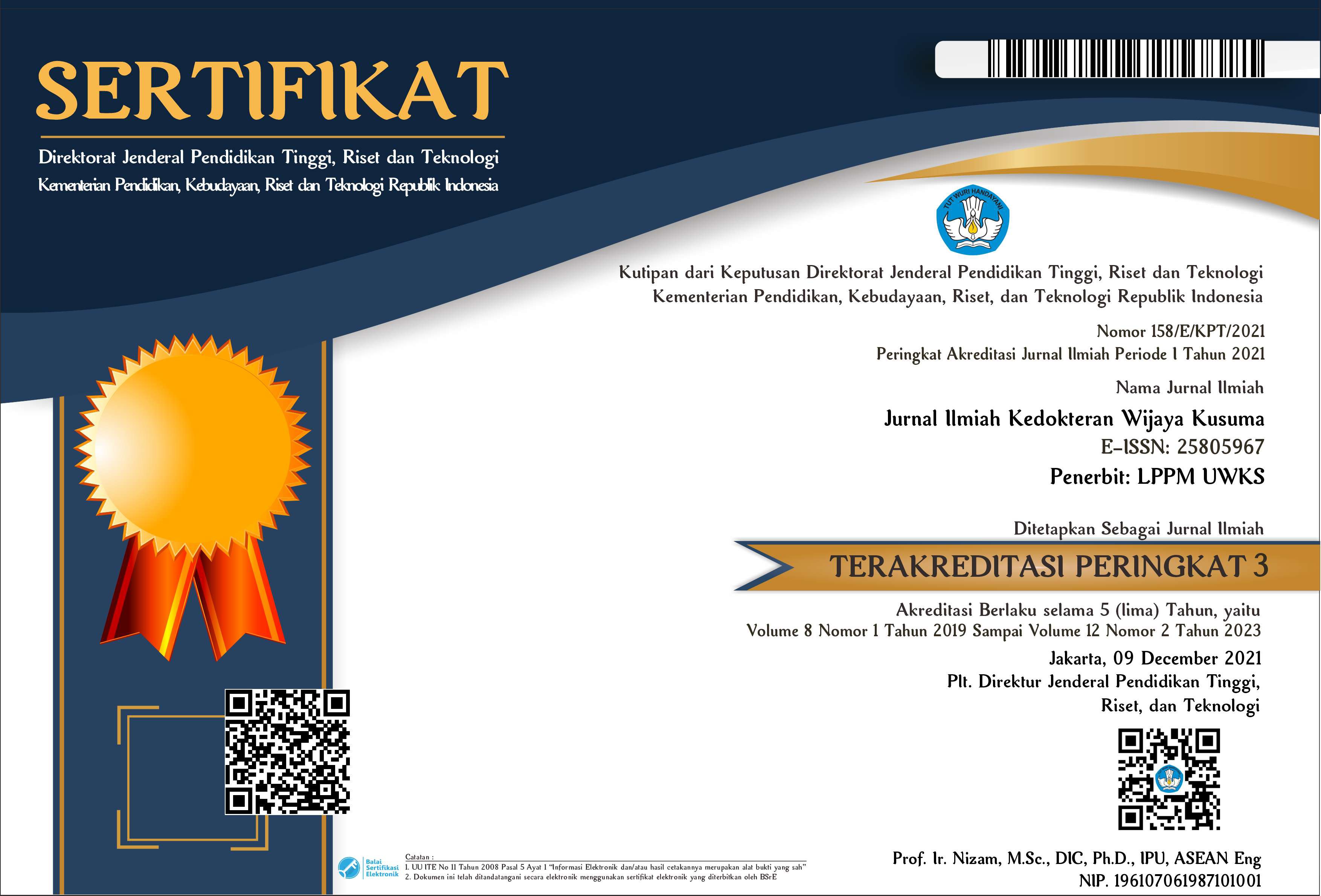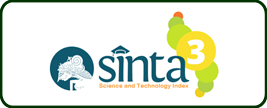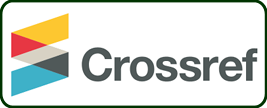Potensi Jus Buah Naga Merah (Hylocereus polyrhizus) terhadap Perbaikan Jaringan Organ Otak Tikus (Rattus norvegicus) Diabetes
DOI:
https://doi.org/10.30742/jikw.v8i2.622Keywords:
diabetes mellitus, jus buah naga merah, kadar glukosa, nekrosis otakAbstract
Diabetes mellitus is a metabolic disease characterized by hyperglycemia due to disturbances in insulin secretion, insulin action, or both. The purpose of this study was to analyze the effect of the red dragon fruit juice (Hylocereus polyrhizus) to repair brain organ histopathologic female wistar rats (Rattus norvegicus Wistar strain) with diabetes. This research is a true experiment research with randomized control - group pretest - posttest design and were conducted at the in Vivo Laboratory of Wijaya Kusuma University Surabaya. Twenty five female wistar rats were randomly divided into 5 groups, normal rats group KA (without alloxan induction), diabetic rats group KB (alloxan induction and without given any red dragon fruit juices), treatment group KC (alloxan induction + 2 gr/2,5ml of red dragon fruit juices), treatment group KD (alloxan induction + 4 gr/2,5ml of red dragon fruit juices) and treatment group KE (alloxan induction + 8 gr/2,5ml of red dragon fruit juices). The study was conducted during the period of 16 days with standard feeding adaptations for 7 days. On day 16, all the rats were terminated. Glucose meter is used to measure the levels of blood glucose in rats. Histopathologic observation of rat brain tissue using a microscope Olympus CX21 with Haematoksilin eosin (HE) staining. The results showed the best dose of red dragon fruit juices to decrease blood glucose levels compare between KB and KE with significance p-value = 0.000 (α < 0.05), the blood glucose levels decreased in diabetic rats significantly between KB and KE also decreased in rat brain tissue necrosis with p-value = 0.000 (α <0.05).
References
American Diabetes Association, 2018. Diabetes Care Volume 37 Supplement 1.Diagnosis and Classification of Diabetes Mellitus. S81 – S90.
Biessels GJ and Reijmer YD, 2014. Brain Changers Underlying Cognitive Dysfuction in Diabetes: What can we learn from MRI. Diabetes, 63(7):2244-2252
Cheville, N. F. 2006. Introduction to Veterinary Pathology, 3rd Ed. Blackwell Publishing. USA.
Diabetes Care. 2018. Standard of Medical Care in Diabetes 2018. VOLUME 41 | SUPPLEMENT 1
David Vauzour, Katerina Vafeiadou, Ana Rodriguez-Mateos, Catarina Rendeiro, Jeremy P. E. Spencer. 2008. The neuroprotective potential of flavonoids: a multiplicity of effects. Molecular Nutrition Group, School of Chemistry, Food and Pharmacy, University of Reading. UK. Pages: 115–126 Elmore
Feranose, Panjuantiningrum. 2009. Pengaruh pemberian buah naga merah (Hylocereus polyrhizus) terhadap kadar glukosa darah Tikus putih yang diinduksi aloksan. UNS Repository.
Fouad T. 2007. Free Radical Source, Type, and Damaging Reaction.
Ghorbani A. Pharmacological properties of Salvia officinalis and its components. Journal of Traditional and Complementary Medicine 7(4) • January 2017
Halliwell B. 2002. Vitamin E and The Treatment and Prevention of Diabetes Mellitus: A Case for Clinical Control. Singapore Medical Journal. Vol 43(9): 479484.
Halliwell B and Gutteridge JMC. 2012. Free radical in Biology and medicine. 4th ed. Oxford University Press
Huang Dezian. Dietary Antioxidants and Health Promotion. Antioxidants 2018 : 7 (9) 1-3
Hui Xu, Jia Luo, Jia Huang, and Qian Wen. Flavonoids intake and risk of type 2 diabetes mellitus A meta-analysis of prospective cohort studies. Medicine (Baltimore). 2018 May; 97(19): e0686.
Infodatin. 2018. Situasi dan Analisis Diabetes. http://www.depkes.go.id/resources/download/pusdatin/infodatin/hari-diabetes-sedunia-2018.pdf
Jing Hong, Kuan-Hsing Chen, Pei-Ching Kuo, Chia-Chi Pao, Jan-Kan Chen Neurodegeneration in StreptozotocinInduced Diabetic Rats Is Attenuated by Treatment with Resveratrol. Neuroendocrinology 2013;98:116–127
Jaafar R., Rahman ARBB, , Mahmod NZC, and Vasudevan R. 2009. American Journal of Applied Sciences 6. Proximate Analysis of Dragon Fruit (Hylecereus polyhizus). 1341 – 1346.
Heim KE, Tagliaferro AR, and Bobilya DH, 2002. Flavonoid antioxidants: chemistry, metabolism, and structure-activity relationships. J Nutr Biochem. 13(10):572-584.
Kementerian Kesehatan RI. Sekretariat Jenderal. 2014. Profil Kesehatan Indonesia Tahun 2013. Jakarta : Kementerian Kesehatan RI. 166 – 167.
Kristanto, D. 2008. Buah Naga Pembudidayaan di Pot dan di Kebun. Penebar Swadaya. Jakarta.
Lenny Sovia. 2006. Senyawa Flavonoida, Fenilpropanoida, dan Alkaloida. USU Repository.
Middleton, E.Jr., Kandaswami, C. dan Theoharides, T.C. (2000). The effects of plant flavonoids on mammalian cells: implications for inflammation, heart disease, and cancer. Pharmacological Reviews 52: 673-751.
Panche A. N. Diwan A. D. and Chandra S. R. 2016. Flavonoids: an overview. Journal of Nutritional Science. https://doi.org/10.1017/jns.2016.41
Pringgoutomo, S.; S. Himawan; A. Tjarta. 2002. Buku Ajar Patologi I. Jakarta: Sagung Seto.
Sarian MN, Ahmed AQ Ahmed, So’ad SJM, Alhassan AM, Murugesu S,
Perumal V, Mohamad SNAS, Khatib A, Latip J. 2017. Antioxidant and Antidiabetic Effects of Flavonoids: A Structure-Activity Relationship Based Study. Hindawi BioMed Research International : Vol 2017, 1-14
Szkudelski. T. 2001. Department of Animal Physiology and Biochemistry, University of Agriculture, Poznan, Poland. The Mechanism of Alloxan and Streptozotocin Action in B Cells of the Rat Pancreas. 536 – 546. Utami P. 2003. Tanaman Obat untuk Mengatasi Diabetes Mellitus. Jakarta: Agromedia Pustaka.
Downloads
Published
Issue
Section
License
The journal operates an Open Access policy under a Creative Commons Attribution-NonCommercial 4.0 International License. Author continues to retain the copyright if the article is published in this journal. The publisher will only need publishing rights. (CC-BY-NC 4.0)

















